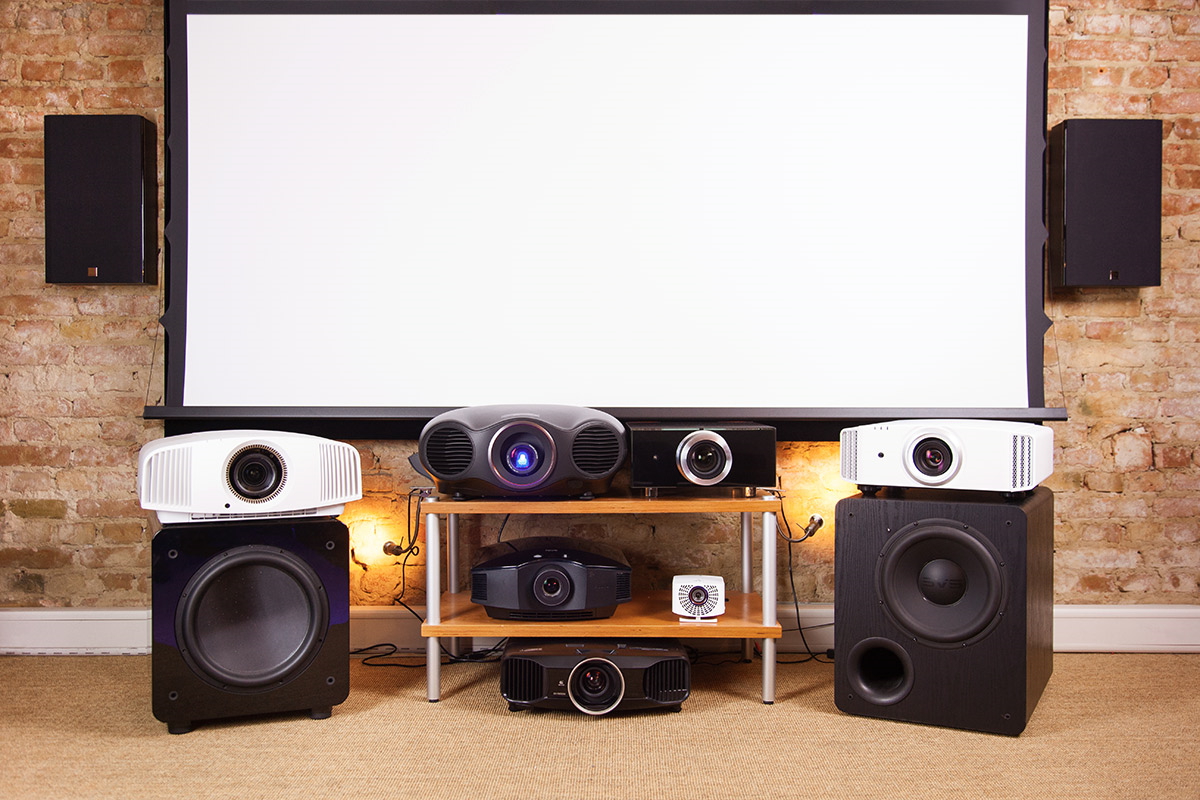Basic Terms
When selecting the right projector, you will come across a great technological diversity. We have already compared the relevant differences between the projection techniques LCD, DLP and LCoS in this article.
So let’s get to the elements of the projector. Below we list some basic terms that you repeatedly stumble upon when dealing with projectors and give a brief explanation of them.
Brightness
If the brightness is too low in bright rooms, you will see little and too much brightness can cause glare in dark rooms. The unit of brightness is ANSI lumen. This indicates how much light a projector can project onto the surface. The larger the projection area and the brighter the surroundings, the more ANSI lumens are required.
Light Source: Projector Lamp
Most projectors use lamps as light sources. There are of course differences:
- Metal halogen lamps combine rare earth metal salts and mercury vapor to produce light.
- UHP Lamps (Ultra High Performance) have similar brightness while consuming less energy.
- The E-TORL lamps are specialized in brightness because the scattering and loss of light have been minimized.
LED Light
The tiny light bulbs of the LEDs (light-emitting diodes) are illuminated by electron flow. Since they have no filaments, they work more efficiently while using less energy than conventional light bulbs.
Hybrid Light Source
Hybrid light sources consist of various light sources such as LED, laser and fluorescence technologies. This produces a bright image while requiring little power.
Light Source: Laser
In a projector with a laser, the three basic colours red, green and blue are each generated with a laser beam. An optical waveguide guides them to a projection head upon the image is projected.
Lamp Run Time
The service life of projector lamps varies enormously. It depends on the particular device, the lamp used and, if available, the eco-mode, which reduces consumption.
Projection Ratio
When selecting the projector, the ratio of distance to image size plays an important role. The desired image width requires a certain distance, while a certain distance to the screen specifies a maximum width. The focal length is given for given image width, and projection distance depends on the size of the chip that generates the image. However, the user is not required to know the chip size, as a projection ratio is usually specified for lenses. In general, however, the distance can be calculated as follows:
Trapezoid Correction
If the projector is placed at a slight angle, the image it projects onto the screen will be distorted. To avoid this, the longer side of the image is digitally compressed, but at the same time, image information is lost. The lens shift counteracts this.
Lens Shift
Lens shift is a function that adjusts the lens. Any distortion is counteracted, and the lens is shifted parallel to the original projection original. No image information is lost, and the image can be enjoyed without distortion.
Iris Diaphragm
Adaptive light or iris diaphragms increase the contrast range of projectors, which also improves the image quality of bright and dark image scenes. Depending on the model, they are adjusted automatically or manually. Therefore, it is always important not to outshine bright scenes and not to supply dark scenes with too little light. Some models do not have an iris diaphragm at all. Their black levels, for example, are regulated by a chip.
Contrast
Contrast represents the maximum difference in brightness between the darkest black and brightest white. Higher contrast results in a richer image. However, the manufacturer’s specifications are somewhat misleading, as a completely black image is followed by a white image. With a checkerboard pattern in black and white, the contrast conditions can be proven more realistically. Dynamic contrast”, by the way, is the dimming or brightening of the backlighting by LCDs.
Fill Rate
The black distance between the individual pixels is called the fly screen effect. This reduces the brightness and contrast of the image, which is why the pixel spacing is continually reduced. The ratio of the area portion of the pixels to the total area is specified in the fill rate.
Projection Ratio
When selecting the projector, the ratio of distance to image size plays an important role. The desired image width requires a certain distance, while a certain distance to the screen specifies a maximum width.
Since centimetres can be decisive when calculating the image width, it is advisable to check the possible image size on site.
If the projector is set to a short focal length, the light yield is optimal. However, the lens quality may cause distortion at the edge of the image. A long focal length of the projector means some loss of light. The image sharpness in the edge area improves.
Final Thoughts
There’s not one projector that’s right for everyone. If you want to set up your own home cinema, you have a whole range of things to consider. The size of the room and the lighting conditions in it give a lot of information about what is required for a projector. But this individual implementation also gives everyone their own personal cinema.
If you have any questions or would like to select the right projector for you, we will be happy to advise you. We also look forward to welcoming you to our Home Cinema Studios so that you can get a first impression of the overall concept.
Update 08.12.2017:
In this video, which was made during our home cinema reopening, Raphael Vogt explains the basics of projector calibration:



